Line & Noise Removal¶
This page provides a description of the regression.cc class Further documentation is available at the following link:
- Regression-documents: List of presentations and documents
Overview¶
Regressions enables the subtraction of noise features from a target channel based on the output of one or more auxiliary channels (see the documents above for how it works). The calculation is conducted over narrow sub-bands (layers) of the total bandwidth of the target channel, with a desired frequency resolution. Performing the calculation over sub-bands simplifies the problem, reducing the calculation from a big filter to small ones. Regression also enables the possibility to consider select the appropriate auxiliary channels for in different frequency bands. Finally, the output of several auxiliary channels can be used to perform multi-correlation analysis.
We introduce the following name convention for each single layer:
- h: target (must be a discrete time series)
- s: prediction
- x: one or more auxiliary channels, M is the number of auxiliary channels
- a: filter, with length 2L+1
- R: autocorrelation matrix (2n*2n dimension, n=M(2L+1))
- C: cross-correlation vector (2n=2M(2L+1) dimension)
- Lambda, P: eigen-values and eigen-vectors matrices related to R (2n*2n dimension, n=M(2L+1))
- Lambda’: eigen-values matrix after the application of the regolators
Implementation¶
The regression class is implemented in the WAT library and contains the following C++ struct :
- Wiener: a structure which contains the values of the filter a.
The following list reports the attributes of regression object:
- kSIZE: the value of L (half-length of filter)
- Edge: a scratch time applied to the boundaries of segment
- chList: WSeries for each channel
- chName: names of the channels
- chMask: integers storing the frequency layers for each channel shouldbe used
- FILTER: Wiener struct storing the filter for each layer
- matrix: matrix R for each layer
- vCROSS: cross-correlation vector C for each layer
- vEIGEN: matrix Lambda’ for each layer
- target: target time series
- rnoise: prediction (s) in time domain
- WNoise: prediction (s) in Time-Frequency domain
- vrank: rank contribution for each layer and for each channel
- vfreq: central frequency of each layer
A number of functions has been written for the regression method. These are classified into the following groups:
| Object Definition | Constructor and destructor |
| Channels definition | Inserting target and auxiliary channel |
| Filter calculation | Calculation of R,C,a,s |
| Getting attributes | Getting attributes |
| Linear Predictor Estimator | Using regression as LPE |
Examples¶
This section reports an example of an analysis performed with the regression method.
| Regression Examples | Regression examples |
| NMAPI integration | Integration in NMAPI Virgo tool |
Regression examples¶
Test on Gaussian noise
In these examples target and witness channels are combination of gaussian noises.
These tests have been suggested by reviewers.
We report for each test a plot containing eigen-values and rank for each witness channel.
Usually target channel is sort of type: H = x + w
where w is noise to be cleaned.
So each script report at the end mean and rms of the following time series:
- x
- clean
- clean-x
This because x and clean should be the same channel, instead clean-x should be 0.
Test1.C Removal of broadband noise using a single, highly correlated witness channel. Output:
Removal of broadband noise using a single, highly correlated witness channel. You can prepare the channels with the desired correlation this way, for instance: Generate time series w(t) and x(t) each containing Gaussian white noise (unit variance) Construct the witness channel: A(t) = w(t) Construct the target channel: H(t) = x(t) + 0.8*w(t) Compare the ASD (or simply the RMS) of H(t) before and after regression. The regression should be able to reduce the noise amplitude by a factor of 1/sqrt(1^2+0.8^2) = 1/sqrt(1.64) ~ 0.78
Results:
Ratio rms: (0.998905/1.28003)= 0.780374 x : 0.000118281 0.999683 clean : -0.000804828 0.998905 clean-x : -0.000923109 0.0817862
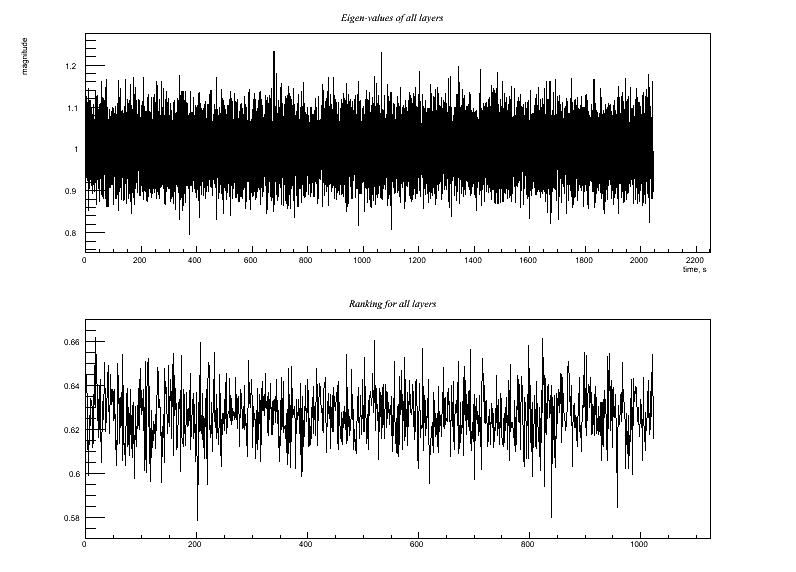
Test2.C Similar, but witness channel includes some uncorrelated noise: Output:
Test 2: Similar, but witness channel includes some uncorrelated noise: Generate white noise time series w(t), x(t), y(t) Witness channel: A(t) = 0.6*y(t) + w(t) Target channel: H(t) = x(t) + 0.8*w(t) Compare the ASD (or simply the RMS) of H(t) before and after regression. Since regression removes the w(t) correlated noise but adds in some y(t) noise from the witness channel, I think the regression should be able to reduce the noise amplitude by a factor of sqrt(1^2+(0.8*0.6)^2)/sqrt(1^2+0.8^2) = sqrt(1.23)/sqrt(1.64) ~ 0.87
Results:
Ratio rms: (1.08211/1.2814)= 0.844474 x : 1.49279e-05 1.00022 clean : 0.000703435 1.08211 clean-x : 0.000688507 0.423346
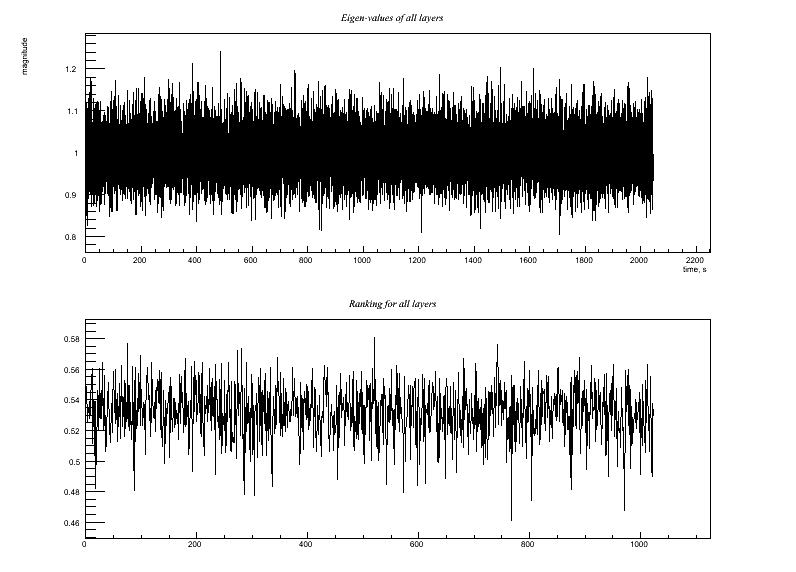
Test3.C Similar, but witness channel includes more uncorrelated noise: Output:
Test 3: Similar, but witness channel includes more uncorrelated noise: Witness channel: A(t) = y(t) + w(t) Target channel: H(t) = x(t) + 0.8*w(t) Compare the ASD (or simply the RMS) of H(t) before and after regression. Since regression removes the w(t) correlated noise but adds an equal amount of y(t) noise, it should not be able to reduce the noise amplitude in H(t).
Results:
Ratio rms: (1.14762/1.27984)= 0.896693 x : -0.000137184 0.999029 clean : 0.000252871 1.14762 clean-x : 0.000390055 0.572221
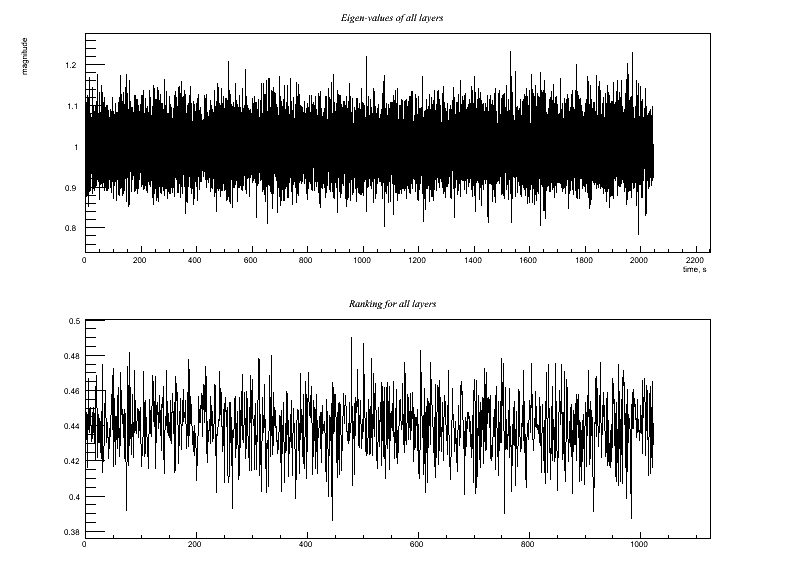
Test4.C Similar, but witness channel has mostly uncorrelated noise. Output:
Test 4: Similar, but witness channel has mostly uncorrelated noise. Witness channel: A(t) = y(t) + 0.5*w(t) Target channel: H(t) = x(t) + 0.8*w(t) Trying to do regression would add more noise that it removes. Is the code smart enough to determine this and choose NOT to use this witness channel for regression?
Results:
Ratio rms: (1.22895/1.28215)= 0.958502 x : 0.000117791 1.00031 clean : 0.000277306 1.22895 clean-x : 0.000159515 0.718146
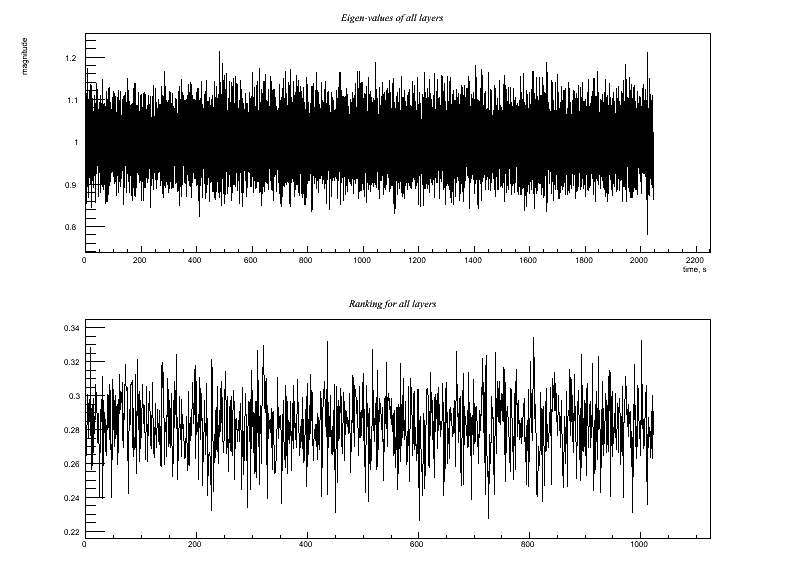
Test5.C Two identical (i.e., redundant) witness channels: Output:
Test 5: Two identical (i.e., redundant) witness channels: Witness channels: A(t) = 0.6*y(t) + w(t) B(t) = A(t) Target channel: H(t) = x(t) + 0.8*w(t) This could be pathological in terms of matrix inversion, but corresponds to a very realistic case of, say, two power-line monitors (with high signal-to-noise) both showing 60 Hz and harmonics, equivalently. The right answer in terms of the regression goal is that we can use EITHER A(t) or B(t) (or any linear combination of them) and achieve the same result as Test 2 above. In other words, I'd like to think that it is harmless to include extra redundant aux channels. So does the code manage to do that? * Try this with hard, soft, and mild regulators *Results:
HARD: Ratio rms: (1.08188/1.28075)= 0.844727 x : -0.00086732 0.99952 clean : -0.000774834 1.08188 clean-x : 9.24859e-05 0.423357 ------------------- SOFT: Ratio rms: (1.07976/1.28075)= 0.843067 x : -0.00086732 0.99952 clean : -0.0007748 1.07976 clean-x : 9.25191e-05 0.418084 ------------------- MILD: Ratio rms: (1.07982/1.28075)= 0.843122 x : -0.00086732 0.99952 clean : -0.000774804 1.07982 clean-x : 9.2516e-05 0.418233 -------------------
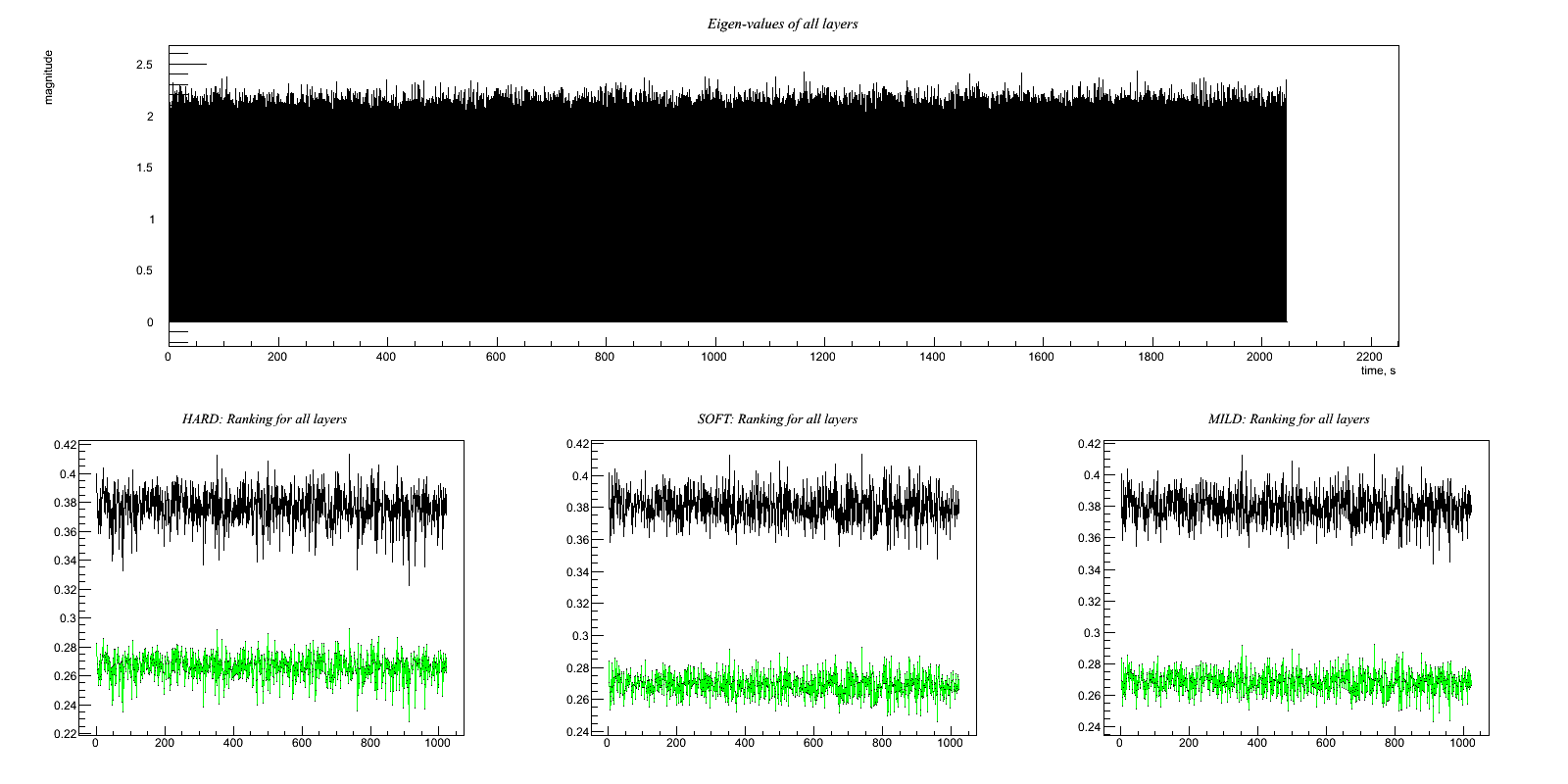
Test6.C Two witness channels, one highly correlated and the other not Output:
Test 6: Two witness channels, one highly correlated and the other not Witness channels: A(t) = y(t) + w(t) B(t) = w(t) Target channel: H(t) = x(t) + 0.8*w(t) Hopefully, the code figures out that it should use B(t) in the regression and ignore A(t). The net reduction in noise should be the same as Test 1 above. * Try this with hard, soft, and mild regulators *
Results:
HARD: Ratio rms: (1.04764/1.28094)= 0.81787 x : -0.000725006 1.00052 clean : -0.000114259 1.04764 clean-x : 0.000610748 0.323453 ------------------- SOFT: Ratio rms: (1.02945/1.28094)= 0.803672 x : -0.000725006 1.00052 clean : -0.000114251 1.02945 clean-x : 0.000610755 0.262148 ------------------- MILD: Ratio rms: (1.03179/1.28094)= 0.805497 x : -0.000725006 1.00052 clean : -0.000114252 1.03179 clean-x : 0.000610755 0.270657 -------------------
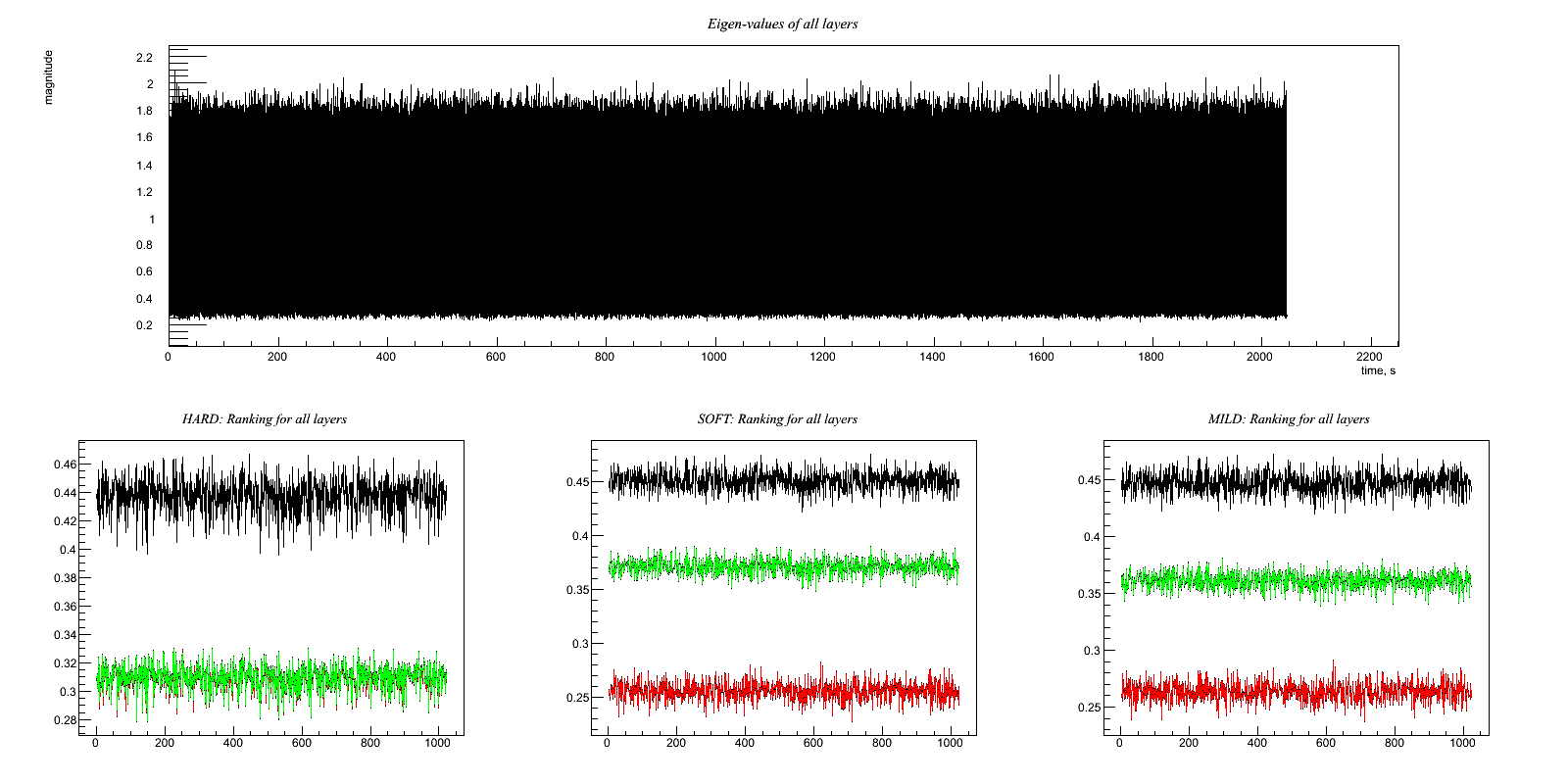
Test7.C One witness channel with a little uncorrelated noise, other with more Output:
Test 7: One witness channel with a little uncorrelated noise, other with more Generate white noise time series w(t), x(t), y(t), z(t) Witness channels: A(t) = 0.6*y(t) + w(t) B(t) = z(t) + 0.5*w(t) Target channel: H(t) = x(t) + 0.8*w(t) Hopefully, the code figures out that it should use A(t) and ignore B(t). The net reduction in noise should be the same as Test 2 above. * Try this with hard, soft, and mild regulators *
Results:
HARD: Ratio rms: (1.11732/1.28115)= 0.872121 x : 0.000533018 1.00039 clean : 0.000452029 1.11732 clean-x : -8.09883e-05 0.504925 ------------------- SOFT: Ratio rms: (1.08964/1.28115)= 0.85052 x : 0.000533018 1.00039 clean : 0.000451997 1.08964 clean-x : -8.10209e-05 0.445032 ------------------- MILD: Ratio rms: (1.08957/1.28115)= 0.850462 x : 0.000533018 1.00039 clean : 0.000452054 1.08957 clean-x : -8.0964e-05 0.445399 -------------------
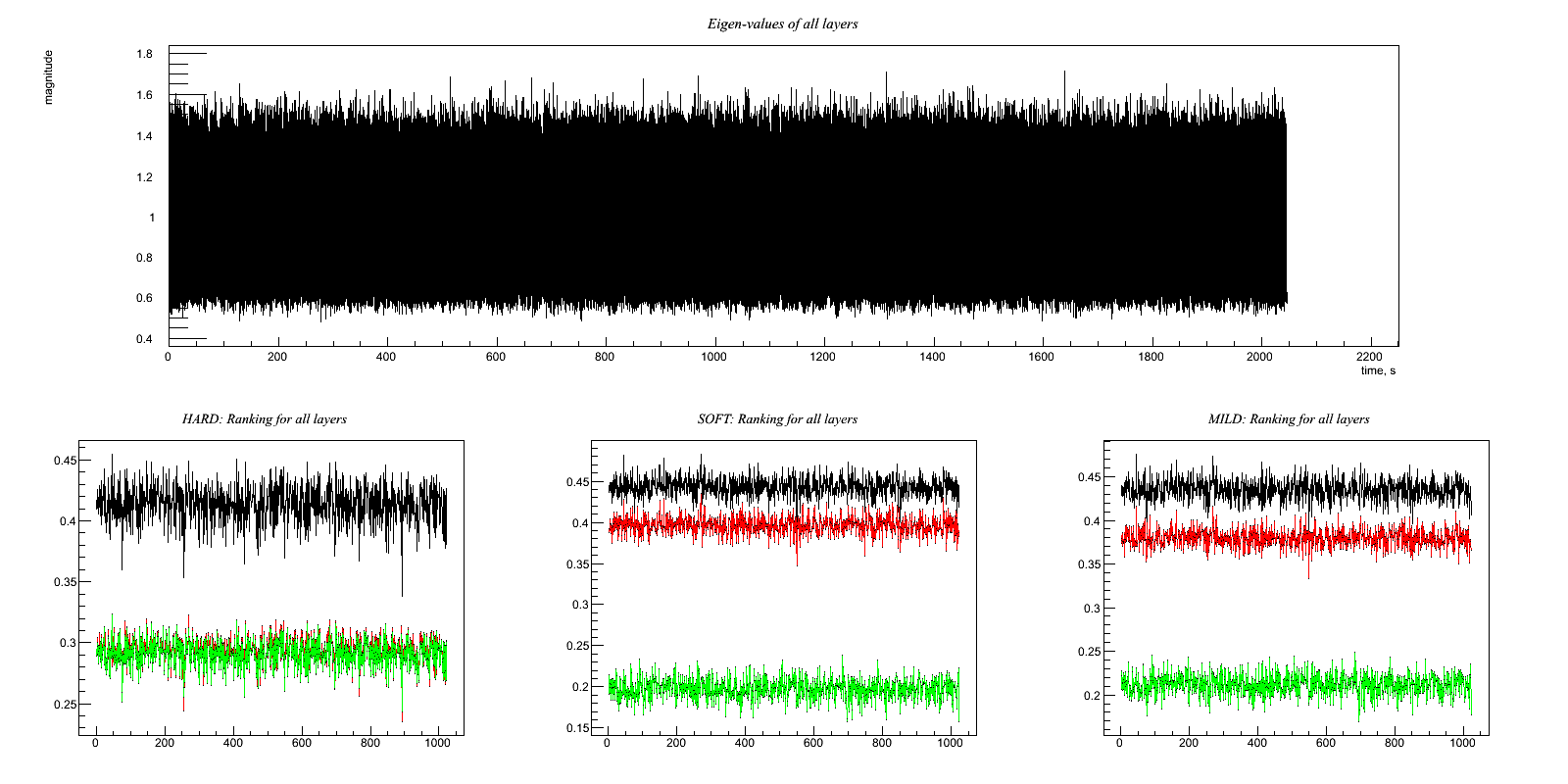
Test8.C Similar, but second witness channel has a very small (but nonzero) correlation Output:
Test 8: Similar, but second witness channel has a very small (but nonzero) correlation Witness channels: A(t) = 0.6*y(t) + w(t) B(t) = z(t) + 0.2*w(t) Target channel: H(t) = x(t) + 0.8*w(t) Hopefully, the code will give the same result as tests 2 and 7 -- i.e. ignore B(t), since trying to use it in the regression would only add noise. * Try this with hard, soft, and mild regulators *
Results:
HARD: Ratio rms: (1.15622/1.2816)= 0.902168 x : 9.92543e-05 1.00016 clean : 0.00050095 1.15622 clean-x : 0.000401696 0.586336 ------------------- SOFT: Ratio rms: (1.08418/1.2816)= 0.84596 x : 9.92543e-05 1.00016 clean : 0.000501103 1.08418 clean-x : 0.000401849 0.426438 ------------------- MILD: Ratio rms: (1.08815/1.2816)= 0.849059 x : 9.92543e-05 1.00016 clean : 0.000501097 1.08815 clean-x : 0.000401843 0.435835 -------------------
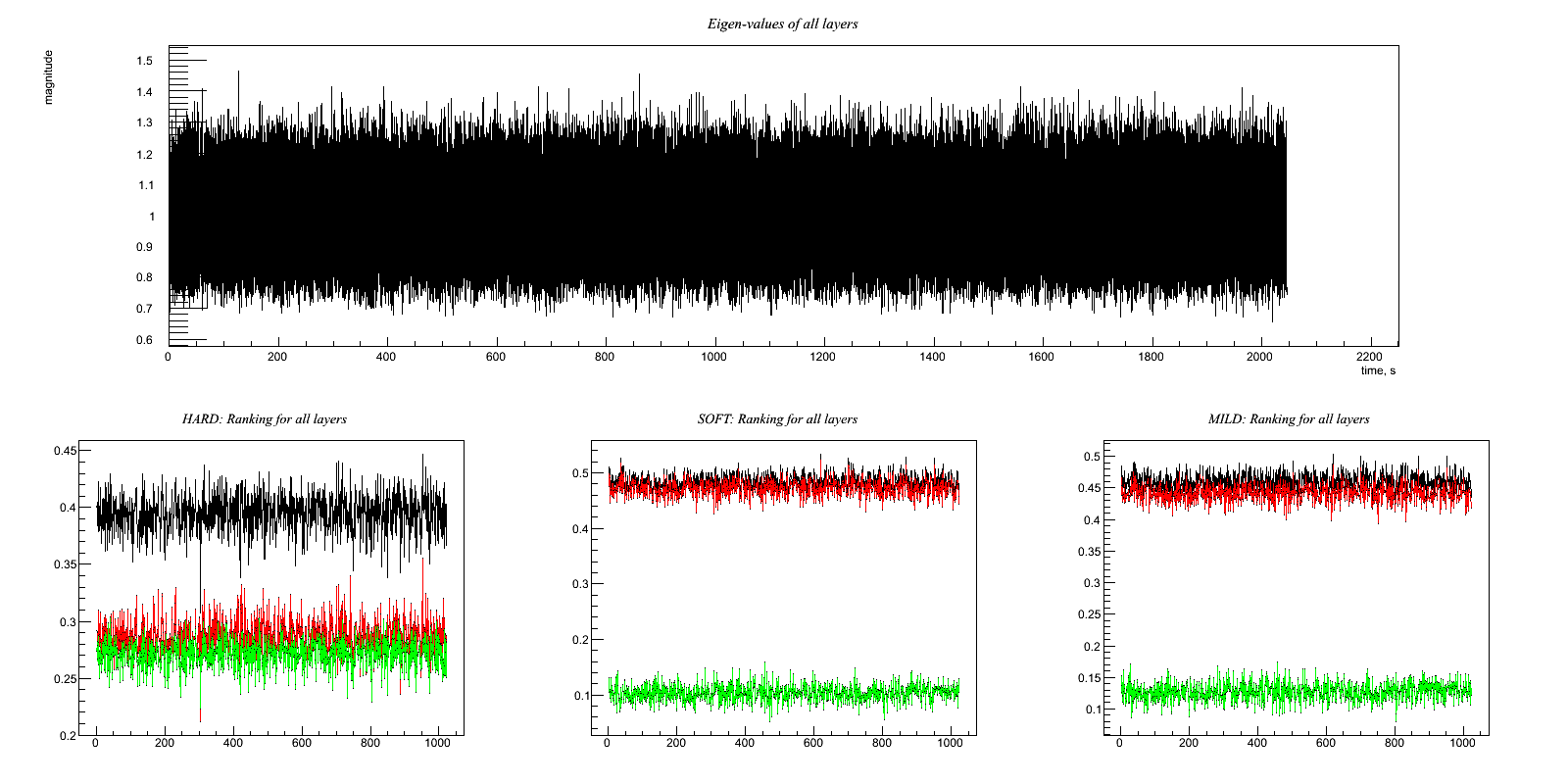
Test9.C Two good witness channels measuring different effects Output:
Test 9: Two good witness channels measuring different effects Witness channels: A(t) = w(t) B(t) = v(t) Target channel: H(t) = x(t) + 0.8*w(t) + 0.6*v(t) Compare the ASD (or simply the RMS) of H(t) before and after regression. The regression should be able to reduce the noise amplitude by a factor of 1/sqrt(1^2+0.8^2+0.6^2) = 1/sqrt(2.00) ~ 0.71
Results:
HARD: Ratio rms: (1.21678/1.41389)= 0.860593 x : 0.000298055 0.999962 clean : -0.000296588 1.21678 clean-x : -0.000594643 0.69913 ------------------- SOFT: Ratio rms: (1.00004/1.41389)= 0.707296 x : 0.000298055 0.999962 clean : -0.000296922 1.00004 clean-x : -0.000594977 0.126131 ------------------- MILD: Ratio rms: (1.00791/1.41389)= 0.712862 x : 0.000298055 0.999962 clean : -0.000296866 1.00791 clean-x : -0.000594921 0.175355 -------------------
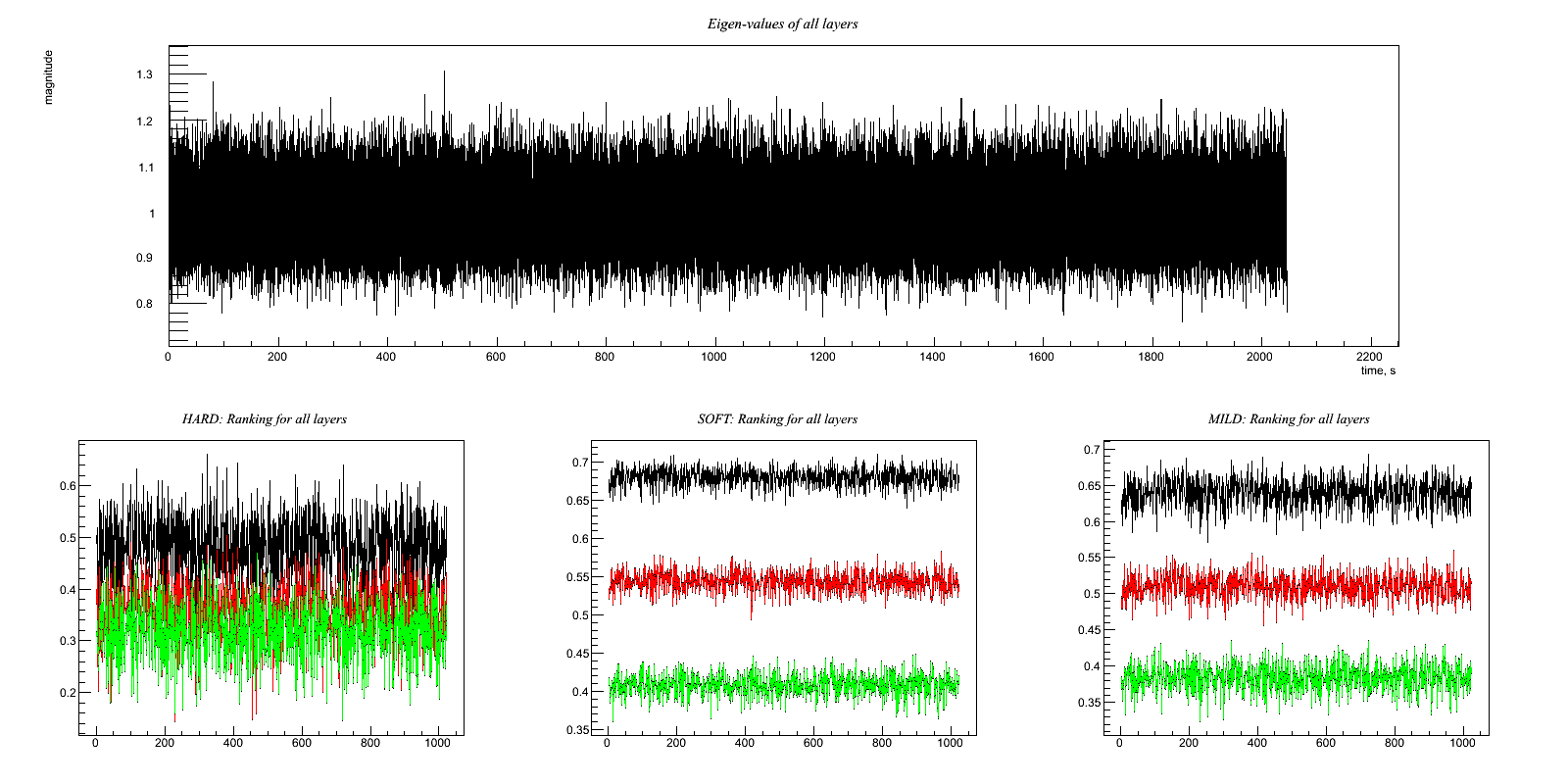
Test10.C Two good witness channels plus one slightly correlated one Output:
Test 10: Two good witness channels plus one slightly correlated one Witness channels: A(t) = w(t) B(t) = v(t) C(t) = y(t) + 0.5*z(t) Target channel: H(t) = x(t) + 0.8*w(t) + 0.6*v(t) + z(t) Compare the ASD (or simply the RMS) of H(t) before and after regression. Although C(t) is correlated, using it in the regression would add more noise than it removes. So hopefully the code will use A and B to regress but ignore C. The result, then, should be the same as Test 9. * Try this with hard, soft, and mild regulators *
Results:
HARD: Ratio rms: (1.64183/1.73322)= 0.947273 x : -0.00166639 0.999727 clean : -0.00175032 1.64183 clean-x : -8.39278e-05 1.3037 ------------------- SOFT: Ratio rms: (1.34039/1.73322)= 0.773353 x : -0.00166639 0.999727 clean : -0.00175059 1.34039 clean-x : -8.42073e-05 0.905124 ------------------- MILD: Ratio rms: (1.35391/1.73322)= 0.781153 x : -0.00166639 0.999727 clean : -0.00175052 1.35391 clean-x : -8.41311e-05 0.924155 -------------------
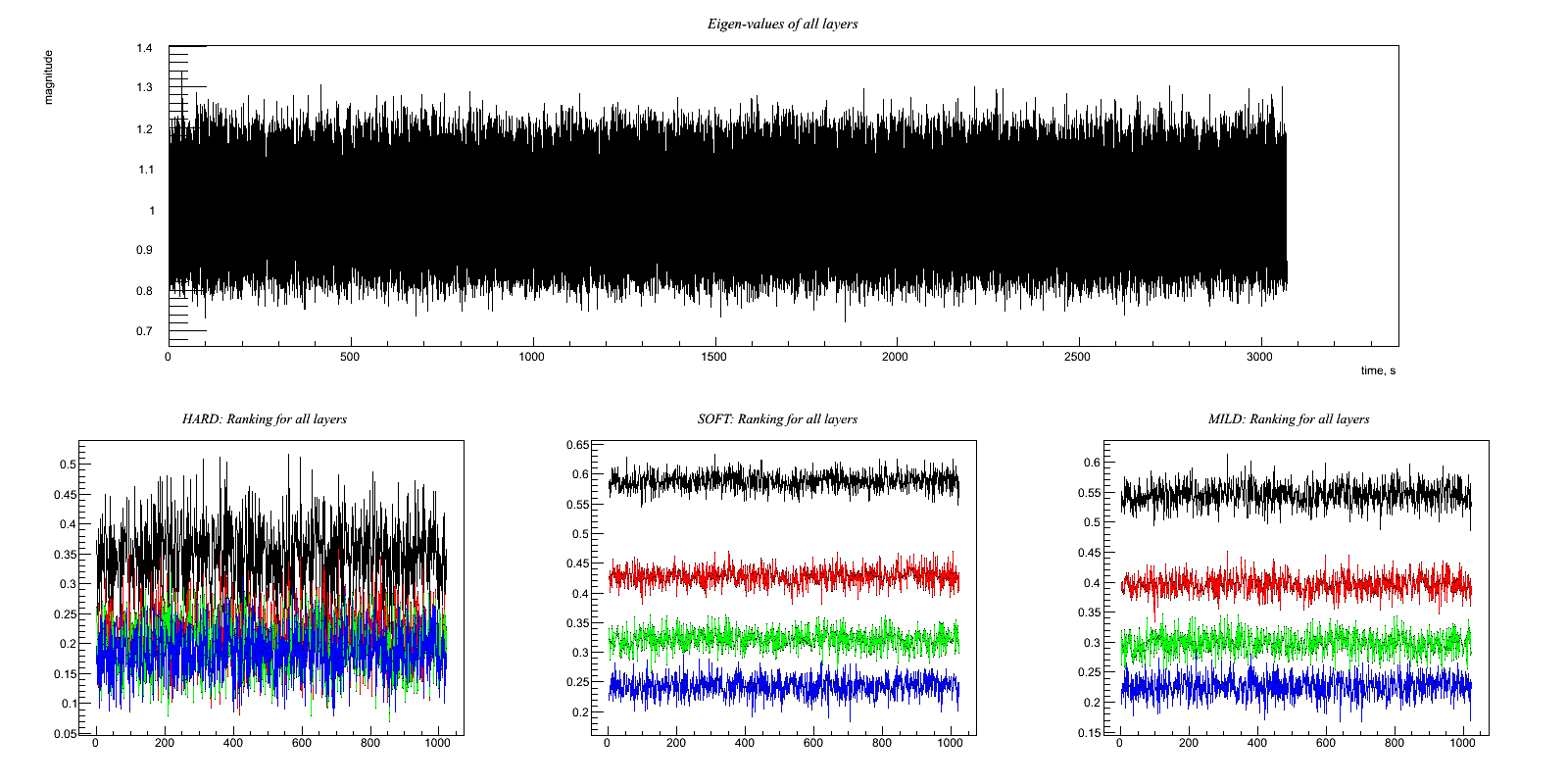
Test11.C Two witness channels have some common noise (or environmental signal, but anyway uncorrelated with the GW target channel) between them Output:
Test 11: Two witness channels have some common noise (or environmental signal, but anyway uncorrelated with the GW target channel) between them Witness channels: A(t) = 0.4*y(t) + w(t) + v(t) B(t) = 0.2*z(t) + 0.5*w(t) + v(t) Target channel: H(t) = x(t) + 0.8*w(t) Hopefully, the code figures out that it should subtract a linear combination of A(t) and B(t). If I've done the math right (on paper), the optimal combination is (0.9933)A(t)-(0.7726)B(t). Note that the v(t) noise mostly (but not completely) cancels out in that combination. The w(t) component amplitude in H(t) reduces from 0.8 to 0.195, although the post-regression H(t) also picks up amplitudes of 0.4*0.9933=0.3973 from the y(t) term in A(t), 0.2*0.7726=0.1545 from the z(t) term in B(t), and 0.9933-0.7726=0.2207 from the combined v(t) terms. So the expected reduction in noise amplitude is by a factor of sqrt(1+(0.195)^2+(0.3973)^2+(0.1545)^2+(0.2207)^2)/sqrt(1^2+0.8^2) = sqrt(1.268)/sqrt(1.64) = 0.88 * Try this with hard, soft, and mild regulators *Results:
HARD: Ratio rms: (1.27988/1.28007)= 0.999849 x : -2.18285e-05 0.999655 clean : 0.00017788 1.27988 clean-x : 0.000199708 0.799899 ------------------- SOFT: Ratio rms: (1.1867/1.28007)= 0.927054 x : -2.18285e-05 0.999655 clean : 0.000177879 1.1867 clean-x : 0.000199707 0.646697 ------------------- MILD: Ratio rms: (1.21162/1.28007)= 0.946523 x : -2.18285e-05 0.999655 clean : 0.000177878 1.21162 clean-x : 0.000199707 0.69103 -------------------
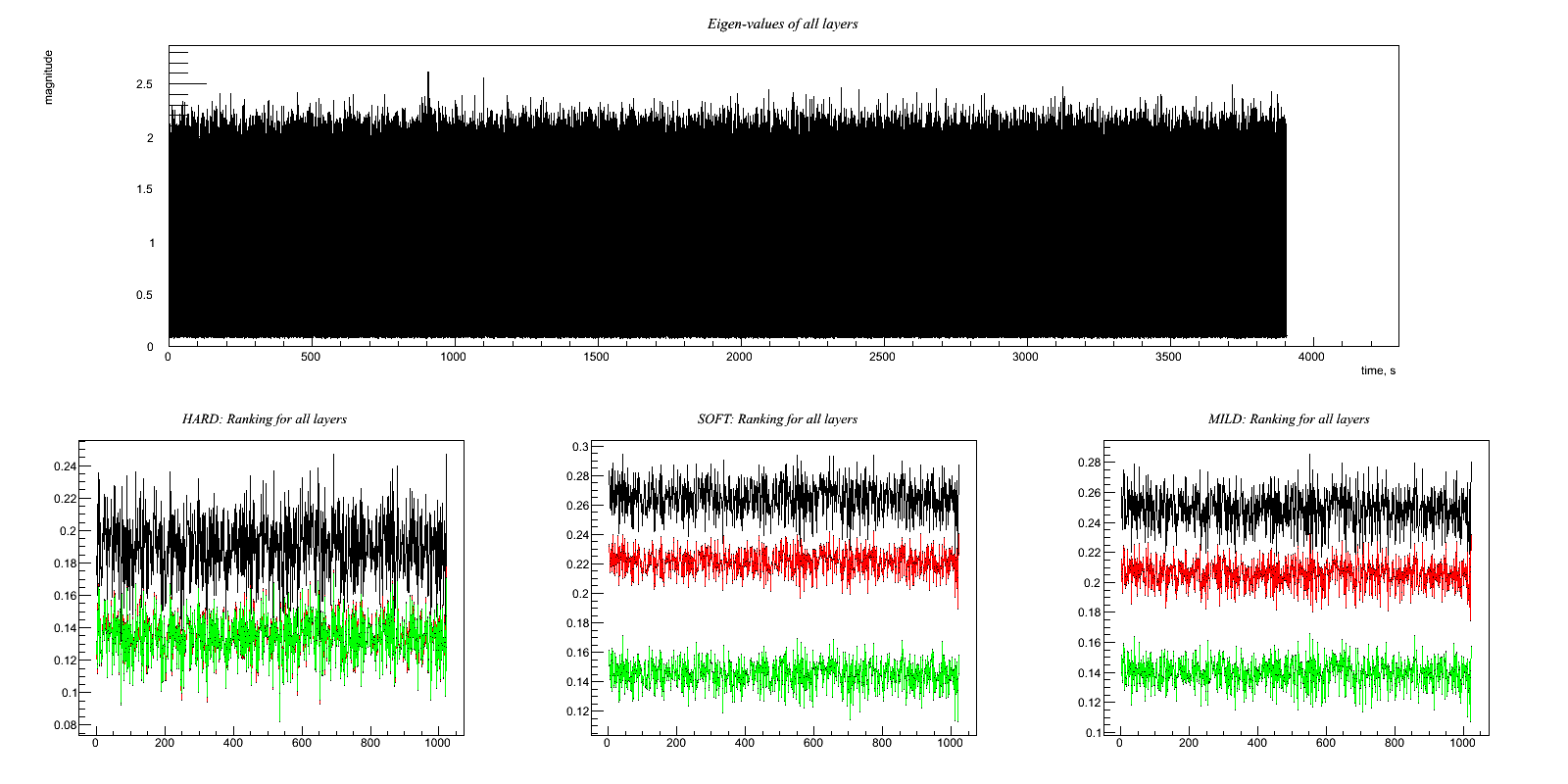
Test on Sinusoidal signal injected in Gaussian noise
In these examples target and witness channels are gaussian noise containing a sinusoidal signal
Regression_Sine.C Clean a sine at 100 Hz . Output:
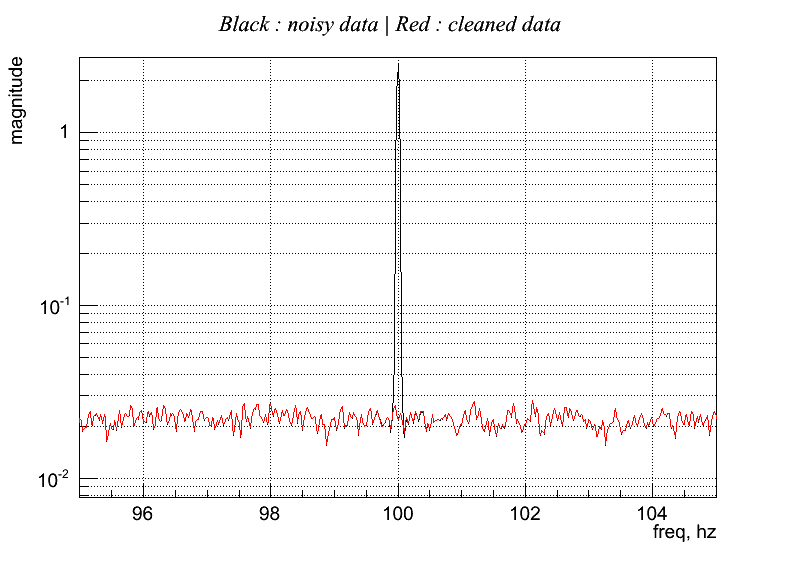
This example write also the rank values and eigenvalues for each layer. Note that in the layers containing only noise the eigen-values are near to one, while in the layer of the sine the eigen-values are very different, and only the biggest are important.
Ranking (freq - rank): 96 0.0380424 97 0.0276262 98 0.0240649 99 0.0140932 100 0.706418 101 0.0324515 102 0.0206146 103 0.00714935 104 0.0321715 Eigen-values at frequency layer (first line is frequency, than eigen-values) 96 97 98 99 100 101 102 103 104 1.110 1.077 1.113 1.073 5.999 1.155 1.071 1.103 1.077 1.110 1.077 1.113 1.073 5.999 1.155 1.071 1.103 1.077 1.092 1.037 1.092 1.065 4.999 1.134 1.059 1.088 1.065 1.092 1.037 1.092 1.065 4.999 1.134 1.059 1.088 1.065 1.045 1.027 1.036 1.055 0.000 1.076 1.040 1.053 1.057 1.045 1.027 1.036 1.055 0.000 1.076 1.040 1.053 1.057 1.026 1.016 1.022 1.029 0.000 1.036 1.035 1.031 1.034 1.026 1.016 1.022 1.029 0.000 1.036 1.035 1.031 1.034 1.013 1.010 1.015 1.001 0.000 0.987 1.034 1.027 1.003 1.013 1.010 1.015 1.001 0.000 0.987 1.034 1.027 1.003 1.002 0.998 0.999 1.000 0.000 0.976 1.009 1.007 0.976 1.002 0.998 0.999 1.000 0.000 0.976 1.009 1.007 0.976 0.976 0.986 0.969 0.993 0.000 0.947 0.988 0.993 0.970 0.976 0.986 0.969 0.993 0.000 0.947 0.988 0.993 0.970 0.953 0.975 0.968 0.972 0.000 0.934 0.964 0.982 0.969 0.953 0.975 0.968 0.972 0.000 0.934 0.964 0.982 0.969 0.948 0.963 0.955 0.952 0.000 0.928 0.951 0.957 0.966 0.948 0.963 0.955 0.952 0.000 0.928 0.951 0.957 0.966 0.932 0.957 0.920 0.934 0.000 0.919 0.933 0.886 0.954 0.932 0.957 0.920 0.934 0.000 0.919 0.933 0.886 0.954 0.904 0.953 0.911 0.926 0.000 0.908 0.916 0.873 0.931 0.904 0.953 0.911 0.926 0.000 0.908 0.916 0.873 0.931
Regression_Sine_parameters.C Clean a sine at 100 Hz . Output: See the difference on parameters:
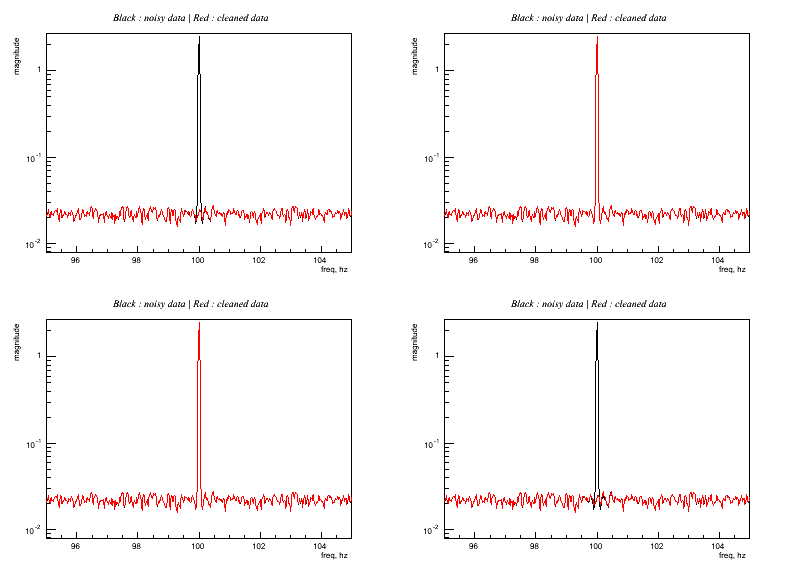
This example shown some changes on the regression parameters showing some conditions which avoid the line cleaning.
Top left:
r.setFilter(5); r.setMatrix(totalscratch); r.solve(0., 4, 'h'); r.apply(0.2);
Top right: same as top left except for:
r2.apply(0.8);
Rank for layer = 100 Hz is 0.7, putting a threshold of 0.8 discard the use of this layer: line is not cleaned
Bottom left: same as top left except for:
r3.solve(0, 2, 'h');
This select only the first 2 eigen-values, which are not enough to describe the line: not cleaned
Bottom right: same as top left except for:
r4.setFilter(2);
The filter is too short to describe the prediction: line is not cleaned
Regression_Sine_Bic.C Clean a sine at 100 +/- 2 Hz using multi-linear correlation. Output:
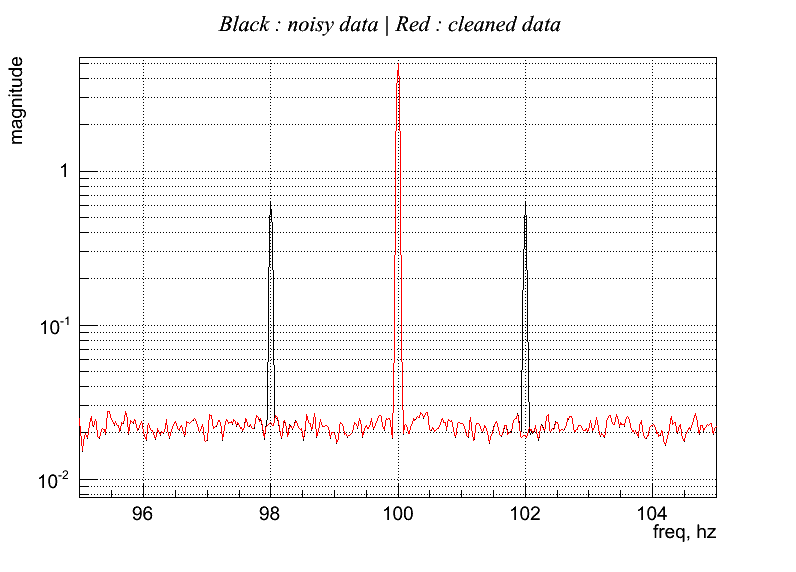
Note that in this example we DID not clean the carrier line at 100 Hz. Same consideration about rank and eigen-values of previous example are now applied at the frequencies 100 +/- 2Hz
Ranking (freq - rank): 96 0.0182773 97 0.028398 98 0.69655 99 0.0195045 100 0.018786 101 0.013739 102 0.696316 103 0.0152138 104 0.00614439 Eigen-values at frequency layer (first line is frequency, than eigen-values) 96 97 98 99 100 101 102 103 104 1.051 1.050 5.988 1.112 1.099 1.133 5.988 1.082 1.057 1.051 1.050 5.988 1.112 1.099 1.133 5.988 1.082 1.057 1.038 1.031 4.990 1.095 1.084 1.096 4.990 1.056 1.041 1.038 1.031 4.990 1.095 1.084 1.096 4.990 1.056 1.041 1.027 1.015 0.003 1.050 1.059 1.065 0.003 1.044 1.030 1.027 1.015 0.003 1.050 1.059 1.065 0.003 1.044 1.030 1.015 1.005 0.003 1.019 1.031 1.053 0.003 1.034 1.030 1.015 1.005 0.003 1.019 1.031 1.053 0.003 1.034 1.030 1.007 1.004 0.003 0.992 1.010 1.016 0.003 1.017 1.029 1.007 1.004 0.003 0.992 1.010 1.016 0.003 1.017 1.029 1.003 1.003 0.003 0.983 0.984 0.994 0.003 0.995 1.016 1.003 1.003 0.003 0.983 0.984 0.994 0.003 0.995 1.016 1.001 0.985 0.002 0.981 0.969 0.982 0.003 0.985 1.001 1.001 0.985 0.002 0.981 0.969 0.982 0.003 0.985 1.001 0.995 0.981 0.002 0.950 0.967 0.941 0.002 0.980 0.997 0.995 0.981 0.002 0.950 0.967 0.941 0.002 0.980 0.997 0.966 0.977 0.002 0.947 0.953 0.921 0.002 0.966 0.981 0.966 0.977 0.002 0.947 0.953 0.921 0.002 0.966 0.981 0.956 0.975 0.002 0.942 0.930 0.903 0.002 0.927 0.918 0.956 0.975 0.002 0.942 0.930 0.903 0.002 0.927 0.918 0.940 0.971 0.002 0.929 0.915 0.895 0.002 0.913 0.900 0.940 0.971 0.002 0.929 0.915 0.895 0.002 0.913 0.900
Regression_Sine_Gaus_Bic.C Clean a Gaussian noise up-converted with a 100 Hz line carrier. Output:
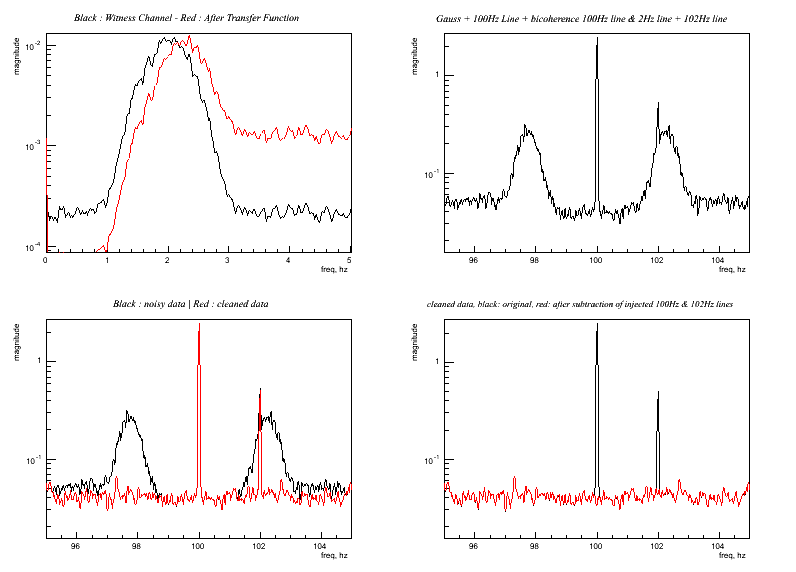
Ranking (freq - rank): 95.5 0.637558 96 0.643526 96.5 0.642644 97 0.822235 97.5 0.973241 98 0.967509 98.5 0.790975 99 0.170191 99.5 0.0908794 100 0.00781286 100.5 0.0615298 101 0.140019 101.5 0.769942 102 0.788914 102.5 0.971866 103 0.813191 103.5 0.634377 104 0.65289 104.5 0.641887 Eigen-values at frequency layer (first line is frequency, than eigen-values) 95.5 96 96.5 97 97.5 98 98.5 99 99.5 100 100.5 101 101.5 102 102.5 103 103.5 104 104.5 1.147 1.115 1.194 2.478 2.206 1.167 2.199 2.801 1.120 1.351 1.121 2.795 2.198 1.159 2.184 2.506 1.182 1.111 1.151 1.147 1.115 1.194 2.478 2.206 1.167 2.199 2.801 1.120 1.351 1.121 2.795 2.198 1.159 2.184 2.506 1.182 1.111 1.151 1.124 1.075 1.167 2.355 2.135 1.150 2.092 2.585 1.103 1.081 1.104 2.578 2.089 1.145 2.116 2.382 1.156 1.080 1.134 1.124 1.075 1.167 2.355 2.135 1.150 2.092 2.585 1.103 1.081 1.104 2.578 2.089 1.145 2.116 2.382 1.156 1.080 1.134 1.095 1.072 1.069 1.604 1.617 1.127 1.460 1.435 1.068 1.075 1.065 1.422 1.451 1.134 1.624 1.603 1.063 1.071 1.106 1.095 1.072 1.069 1.604 1.617 1.127 1.460 1.435 1.068 1.075 1.065 1.422 1.451 1.134 1.624 1.603 1.063 1.071 1.106 1.041 1.069 1.026 1.374 1.376 1.123 1.298 1.197 1.057 0.995 1.059 1.191 1.295 1.132 1.386 1.365 1.025 1.071 1.048 1.041 1.069 1.026 1.374 1.376 1.123 1.298 1.197 1.057 0.995 1.059 1.191 1.295 1.132 1.386 1.365 1.025 1.071 1.048 0.999 1.055 1.006 0.911 1.004 1.086 0.980 0.779 1.044 0.992 1.045 0.789 0.991 1.093 1.017 0.900 1.006 1.055 1.000 0.999 1.055 1.006 0.911 1.004 1.086 0.980 0.779 1.044 0.992 1.045 0.789 0.991 1.093 1.017 0.900 1.006 1.055 1.000 0.984 0.994 0.980 0.652 0.837 1.020 0.838 0.611 1.026 0.976 1.025 0.617 0.843 1.020 0.842 0.645 0.979 0.991 0.990 0.984 0.994 0.980 0.652 0.837 1.020 0.838 0.611 1.026 0.976 1.025 0.617 0.843 1.020 0.842 0.645 0.979 0.991 0.990 0.982 0.981 0.958 0.446 0.615 0.968 0.724 0.456 0.984 0.963 0.982 0.457 0.722 0.964 0.614 0.436 0.964 0.981 0.988 0.982 0.981 0.958 0.446 0.615 0.968 0.724 0.456 0.984 0.963 0.982 0.457 0.722 0.964 0.614 0.436 0.964 0.981 0.988 0.937 0.954 0.951 0.370 0.424 0.925 0.521 0.343 0.950 0.925 0.945 0.347 0.523 0.920 0.425 0.360 0.962 0.959 0.927 0.937 0.954 0.951 0.370 0.424 0.925 0.521 0.343 0.950 0.925 0.945 0.347 0.523 0.920 0.425 0.360 0.962 0.959 0.927 0.918 0.911 0.933 0.327 0.358 0.884 0.419 0.297 0.934 0.911 0.929 0.302 0.421 0.880 0.360 0.321 0.944 0.910 0.906 0.918 0.911 0.933 0.327 0.358 0.884 0.419 0.297 0.934 0.911 0.929 0.302 0.421 0.880 0.360 0.321 0.944 0.910 0.906 0.905 0.898 0.872 0.248 0.227 0.791 0.252 0.253 0.866 0.896 0.872 0.256 0.251 0.790 0.230 0.248 0.874 0.897 0.892 0.905 0.898 0.872 0.248 0.227 0.791 0.252 0.253 0.866 0.896 0.872 0.256 0.251 0.790 0.230 0.248 0.874 0.897 0.892 0.868 0.875 0.845 0.235 0.199 0.760 0.218 0.243 0.847 0.834 0.854 0.247 0.216 0.763 0.202 0.235 0.845 0.874 0.858 0.868 0.875 0.845 0.235 0.199 0.760 0.218 0.243 0.847 0.834 0.854 0.247 0.216 0.763 0.202 0.235 0.845 0.874 0.858
Real Data
These two scripts need the list of frame files for target and auxiliary channel.
They work on CIT at: /home/drago/Regression-Phase/Review.
- Regression_H1.C
How to apply regression to subtract power line at 180Hz. Output: ( )
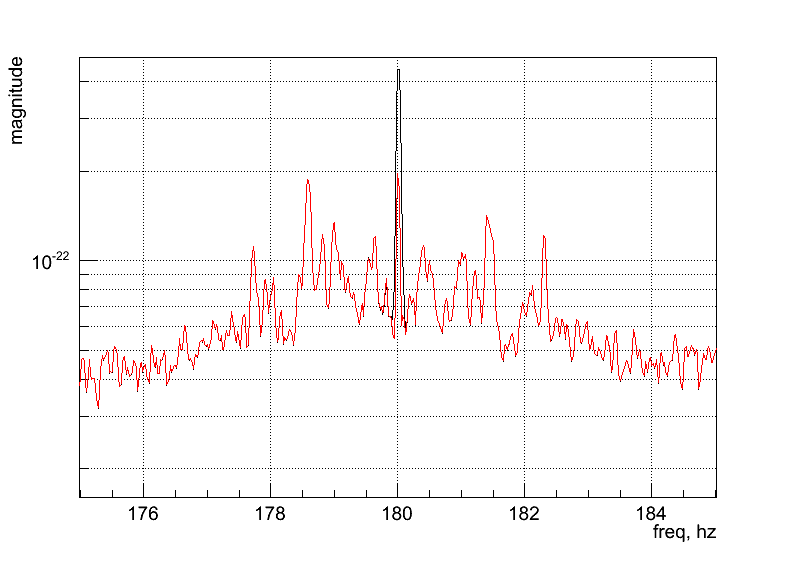
- Regression_H1_bic.C
How to apply regression to subtract power line at 180Hz and related
sidebands. Output: ( )
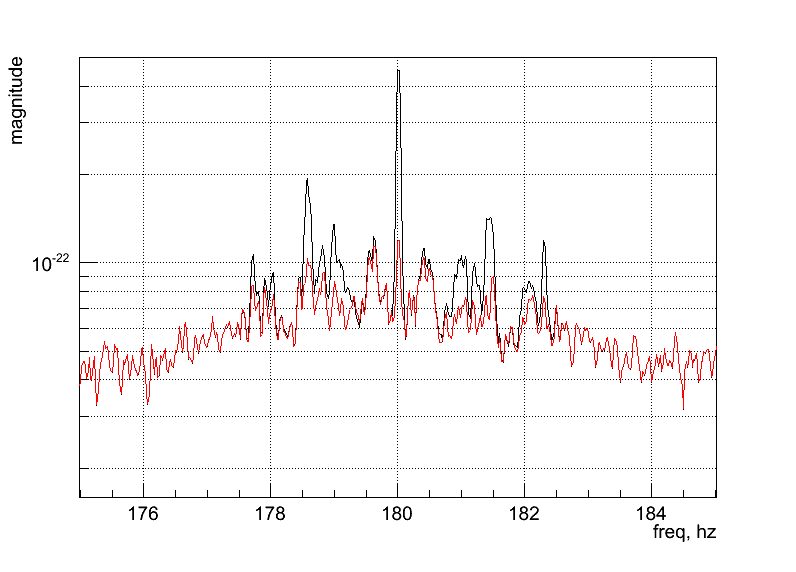
- Regression_H1.C
How to apply LPE on all frequency band using regression. Output: ( )
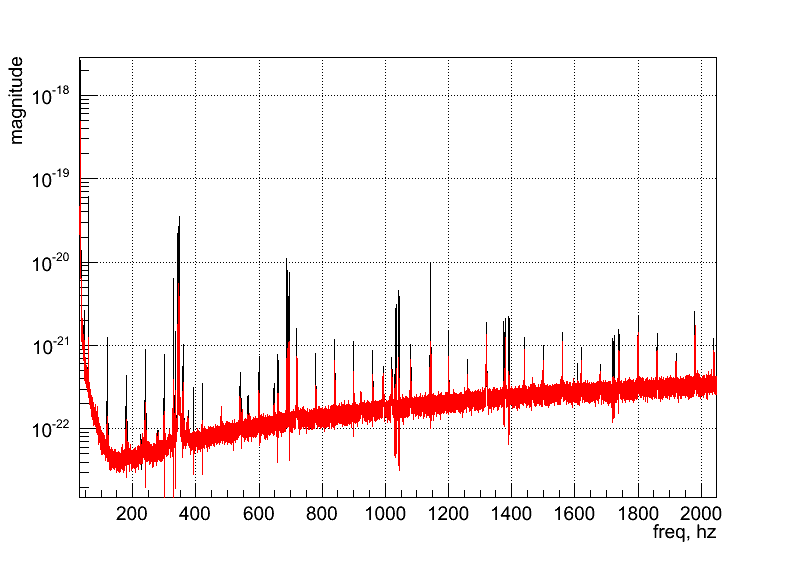
NMAPI integration¶
Integration in NMAPI Virgo tool
NMAPI (Noise Monitor Application Programming Interface) is a Virgo tool which interfaces various Noise Monitors developed by Virgo scientists. Some documents about NMAPI are in the following links (some are Virgo protected):
- Noise Monitor Application Programming Interface (NMAPI) Software Requirements
- Noise Monitor Applicationrogramming Interface (NMAPI) Development Report
- NMAPI and NoEMi for Advanced Detectors
- Noise Monitor Application rogramming Interface (NMAPI) - Latest developments
All the scripts are located in the Cascina cluster. NMAPI uses condor interface to submit the jobs related for each query received from the web.
Regression integration in NMAPI is dedicated for bilinear correlations of Virgo auxiliary channels with the gravitational one. We considered two carrier channels:
- Pr_power50 for power lines
- V1:Pr_B5_ACp for calibration lines
The results are given in appropriate figure of merits reporting for each frequency band (1Hz resolution, centered at an integer number of frequency) the rank value of the correlation (rank near to 1, high correlation).
Regression in NMAPI involves two different output:
- Database query: on a set of selected channels.
- On-the-fly query: on the all possible set of channels.
Database query
The idea is to have an online analysis of bi-linear correlation of a small set of defined channel (about 10-20). After saving the rank values on-the-fly, the user can recall the results for the desired period and channels. The code is split in two parts:
The directory which creates the database. An example is on the dir: /users/drago/Regression/VSR4 It is stricly hard-coded, in the example it consider 24 channels on the frequency band of 0-2048 Hz.
- The script which query the database: /a/st7/storage/d001/web/nmapi/NMAPI_scripts/RegressionThe input parameters are:
- An identificative number given by NMAPI
- Auxiliary channel
- Time period: Start and Stop
- Frequency band: Low and High
- Frequency resolution for the output figure (It collects more frequency bins in the same one reporting the maximum value)
The script file is Regression.sh which calls DrawRankChannel.C
On the fly query
This allows to obtain the bi-linear ranking for each channel in the frame, at a limited period of a single job. The scripts called by NMAPI are located in the directory: /a/st7/storage/d001/web/nmapi/NMAPI_scripts/Regression_QueryChannel. The main script is Regression_QueryChannel.csh which call the macro Regression_QueryChannel.C
- An identificative number given by NMAPI
- Auxiliary channel
- Time period: Start and length
- Frequency band: Low and High
- Ranking threshold of results (write frequencies with rank greater than threshold)
List of constructor and destructor¶
This page shows the list of functions used by the regression class as object constructors and destructors in the c++ language.
- regression::regression()
- Default constructor
- regression::regression(const regression&)
- Copy constructor from another regression object
- regression::operator_
- Copy constructor from another regression object
- regression::regression(WSeries<double> &, char*, double fL=0., double fH=0.)
- Constructor inserting target channel as a WSeries object. It calls the
- regression::add() function. See also Channels definition
- regression::clear()
- Clear the regression object. All the inserted channels are removed.
- regression::_regression
- Default distructor. It calls the function clear()
Inserting target and auxiliary channels¶
regression::add(WSeries<double> & target, char* name, double fL=0., double fH=0.) Add the target channel. It is possible to specify a desired frequency band. If not, all the frequency band of the target is considered.
regression::add(wavearray<double>& witness, char* name, double fL=0., double fH=0.) Add one auxiliary channel. It is possible to specify a desired frequency band. If not, all the frequency band of the auxiliary is considered.
regression::add(int n, int m, char* name) Add an auxiliary channel as a multiplication of two already inserted channels. The relative frequency band depends on the original channels.
- regression::mask(int n, double flow=0., double fhigh=0.)
Discard a frequency band for a specific channel (both target and auxiliary).
- regression::unmask(int n, double flow=0., double fhigh=0.)
Add a frequency band precedently discarded for a specific channel
(both target and auxiliary)
Getting attributes¶
For the meaning of the following quantities see Regression-documents
- regression::channel(size_t n) Get time series for channel n.
- regression::getTFmap(int n=0) Get time-frequency wseries for channel n.
- regression::getMatrix(size_t n=0) Get matrix R for a definite layer.
- regression::getVCROSS(size_t n=0) Get matrix C for a definite layer.
- regression::getVEIGEN(int n=-1) Get matrix Lambda for a definite layer.
- regression::getFILTER(char c=’a’, int nT=-1, int nW=-1) extract filter for target index nT and witness nW.
- regression::getNoise() Get Prediction s in time domain.
- regression::getWNoise() Get prediction s in time-frequency domain.
- regression::getClean() Get difference between target and prediction in time domain.
- regression::getRank(int n) Get rank values of alllayers related to a definite channel (or the contribution of all channels).
- regression::rank(int nbins=0, double fL=0., double fH=0.) Get rank value for a definite frequency band selecting the biggest values of the layers.
Using regression as LPE
More specifically, the code use as witness channel the target channel itself. This is the code implemented in the function:
// regression parameters
#define REGRESSION_FILTER_LENGTH 8
#define REGRESSION_MATRIX_FRACTION 0.95
#define REGRESSION_SOLVE_EIGEN_THR 0.
#define REGRESSION_SOLVE_EIGEN_NUM 10
#define REGRESSION_SOLVE_REGULATOR 'h'
#define REGRESSION_APPLY_THR 0.8
layers = rateANA/8;
WDM<double> WDMlpr(layers,layers,6,10); // set LPE filter WDM
pTF[i]->Forward(*hot[i],WDMlpr);
regression rr(*pTF[i],const_cast<char*>("target"),1.,cfg.fHigh);
rr.add(*hot[i],const_cast<char*>("target"));
rr.setFilter(REGRESSION_FILTER_LENGTH);
rr.setMatrix(NET.Edge,REGRESSION_MATRIX_FRACTION);
rr.solve(REGRESSION_SOLVE_EIGEN_THR,REGRESSION_SOLVE_EIGEN_NUM,REGRESSION_SOLVE_REGULATOR);
rr.apply(REGRESSION_APPLY_THR);
*hot[i] = rr.getClean();
In this case, to avoid the over-fitting between target and witness, the matrix R and vector C are modified, in particular:
- the values on the diagonal of R are put to zero
- the components L and L+(2L+1) of the vector C and (of 2(2L+1) components) are put to zero.